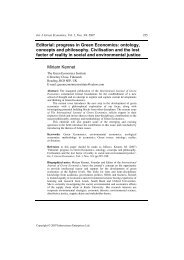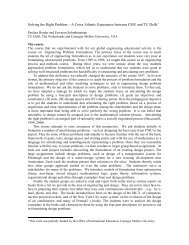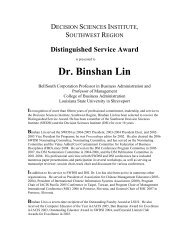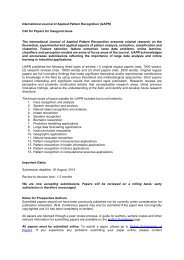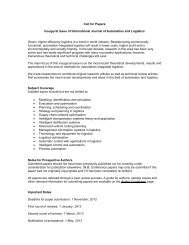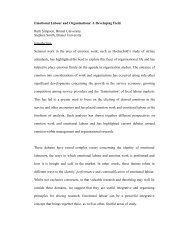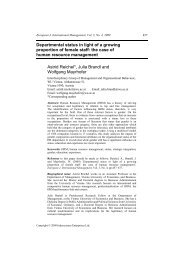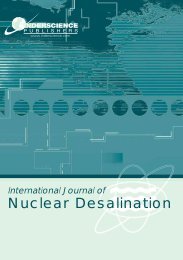A new Zeitgeist for international business activity and ... - InderScience
A new Zeitgeist for international business activity and ... - InderScience
A new Zeitgeist for international business activity and ... - InderScience
Create successful ePaper yourself
Turn your PDF publications into a flip-book with our unique Google optimized e-Paper software.
A <strong>new</strong> <strong>Zeitgeist</strong> <strong>for</strong> <strong>international</strong> <strong>business</strong> <strong>activity</strong> <strong>and</strong> scholarship 289<br />
Table 5<br />
IB <strong>activity</strong> <strong>and</strong> the changing human environment (Institutions (INST))<br />
At the firm level (0) At the country level (L) At the firm level (I)<br />
Institutional assets as a<br />
competitive advantage<br />
Social capital<br />
Collaborative ventures<br />
(to make better use of HE)<br />
Meta-globalisation<br />
Macro institutions (market<br />
cf extra market)<br />
Networking<br />
Exposure to multiple (<strong>for</strong>eign)<br />
institutions <strong>and</strong> mindsets<br />
Attitudes to<br />
change/risk/uncertainty<br />
Stewardship responsibilities<br />
Reappraising corporate<br />
legitimacy<br />
Increasing contribution of<br />
<strong>for</strong>eign subsidiaries to<br />
institution building of global<br />
companies<br />
Micro institutions<br />
Formal → in<strong>for</strong>mal:<br />
specific types 1<br />
Institutional comparative<br />
advantage<br />
Influence of <strong>new</strong> actors<br />
(e.g., NGOs)<br />
Institutional distance<br />
Outsourcing (the human<br />
dimension)<br />
Coordinating global<br />
institutional assets<br />
Increased focus on<br />
minimising systemic<br />
transaction costs<br />
Changes in intentions of<br />
firms <strong>and</strong> the<br />
entrepreneurial content of<br />
decision taking<br />
1 Including those designed to strengthen entrepreneurial development <strong>and</strong> economic<br />
motivation, protect private property, set out rules <strong>for</strong> guiding commercial behaviour,<br />
promote competition, encourage innovation <strong>and</strong> knowledge development, <strong>and</strong> ensure<br />
social equity <strong>and</strong> adequate safety nets.<br />
In Table 4 we set out some of the variables, specific to the PE in which they are housed,<br />
which the extant literature would suggest are most likely to influence the competitiveness<br />
of firms <strong>and</strong> the locational attractions of countries. We would particularly emphasise four<br />
of these influences:<br />
• the importance to both firms <strong>and</strong> countries of the extent <strong>and</strong> quality of all <strong>for</strong>ms of<br />
knowledge, <strong>and</strong> its supporting (physical) infrastructure<br />
• the widening context of internalisation (transaction cost lowering) advantages<br />
(to embrace aspects of value creation as well as value capture)<br />
• the role of distance reducing technologies, as they make <strong>for</strong> the easier access of firms<br />
to global assets <strong>and</strong> competences, <strong>and</strong> a widening of their locational choices<br />
• the exposure of both firms <strong>and</strong> countries to a more heterogeneous mix of institutions<br />
<strong>and</strong> governance systems in the global economy (Rondinelli <strong>and</strong> Behrman, 2000;<br />
Xu <strong>and</strong> Shenkar, 2002; Ozawa, 2003; Griffiths <strong>and</strong> Zammuto, 2005).<br />
Taken together, we believe that these developments represent a <strong>new</strong> <strong>Zeitgeist</strong> – or at least<br />
a reconfiguration <strong>and</strong> extension of the earlier <strong>Zeitgeist</strong> – of PE. 6<br />
We regard the contents of Table 5 as the core of the <strong>new</strong> <strong>Zeitgeist</strong> of the HE.<br />
While these may be familiar to many IB scholars, we do not think they have been fully<br />
incorporated into the mainstream body of knowledge. The table sets out (what in our<br />
view are) some of the critical ingredients of the contemporary HE, which underpin <strong>and</strong>




